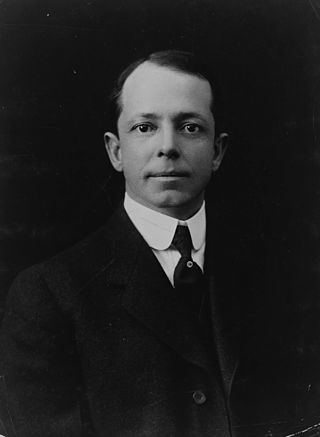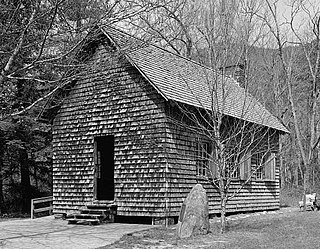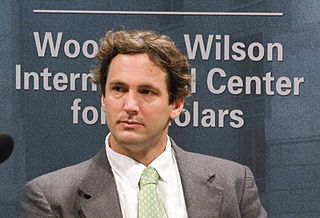Related Research Articles

The Civilian Conservation Corps (CCC) was a voluntary government work relief program that ran from 1933 to 1942 in the United States for unemployed, unmarried men ages 18–25 and eventually expanded to ages 17–28. The CCC was a major part of President Franklin D. Roosevelt's New Deal that supplied manual labor jobs related to the conservation and development of natural resources in rural lands owned by federal, state, and local governments. The CCC was designed to supply jobs for young men and to relieve families who had difficulty finding jobs during the Great Depression in the United States. There was eventually a smaller counterpart program for unemployed women called the She-She-She Camps, which were championed by Eleanor Roosevelt.
The conservation movement, also known as nature conservation, is a political, environmental, and social movement that seeks to manage and protect natural resources, including animal, fungus, and plant species as well as their habitat for the future. Conservationists are concerned with leaving the environment in a better state than the condition they found it in. Evidence-based conservation seeks to use high quality scientific evidence to make conservation efforts more effective.

Forestry is the science and craft of creating, managing, planting, using, conserving and repairing forests and woodlands for associated resources for human and environmental benefits. Forestry is practiced in plantations and natural stands. The science of forestry has elements that belong to the biological, physical, social, political and managerial sciences. Forest management plays an essential role in the creation and modification of habitats and affects ecosystem services provisioning.

Gifford Pinchot was an American forester and politician. He served as the fourth chief of the U.S. Division of Forestry, as the first head of the United States Forest Service, and as the 28th governor of Pennsylvania. He was a member of the Republican Party for most of his life, though he joined the Progressive Party for a brief period.

A forester is a person who practises forestry, the science, art, and profession of managing forests. Foresters engage in a broad range of activities including ecological restoration and management of protected areas. Foresters manage forests to provide a variety of objectives including direct extraction of raw material, outdoor recreation, conservation, hunting and aesthetics. Emerging management practices include managing forestlands for biodiversity, carbon sequestration and air quality.
American Forests is a 501(c)(3) non-profit conservation organization, established in 1875, and dedicated to protecting and restoring healthy forest ecosystems. The current headquarters are in Washington, D.C.

Yale School of the Environment (YSE) is a professional school of Yale University. It was founded to train foresters, and now trains environmental students through four 2-year degree programs, two 10-month mid-career programs, and a 5-year PhD program. Still offering forestry instruction, the school has the oldest graduate forestry program in the United States.

The Michigan Department of Natural Resources (DNR) is the agency of the state of Michigan charged with maintaining natural resources such as state parks, state forests, and recreation areas. It is governed by a director appointed by the Governor and accepted by the Natural Resources Commission. Currently the Director is Daniel Eichinger. The DNR has about 1,400 permanent employees, and over 1,600 seasonal employees.

Henry Solon Graves was a forest administrator in the United States. He co-founded the Yale Forest School in 1900, the oldest continuous forestry school in the United States. He was appointed Chief of the United States Forest Service in 1910 and served in this position until 1920.

The Sustainable Forestry Initiative (SFI) is a sustainability organization operating in the U.S. and Canada that works across four pillars: standards, conservation, community, and education. SFI was founded in 1994 by the American Forest & Paper Association (AF&PA). SFI is the world's largest single forest certification standard by area. SFI is headquartered in Ottawa and Washington, D.C.
Carl Alwin Schenck was a German forester and pioneering forestry educator. When Schenck came to the United States to work for George W. Vanderbilt at the Biltmore Estate, he became the third formally trained forester in the United States. He established and operated the Biltmore Forest School, the first forestry school in North America, on Vanderbilt's property.

The Biltmore Forest School was the first school of forestry in North America. Carl A. Schenck founded this school of "practical forestry" in 1896 on George W. Vanderbilt's Biltmore Estate near Asheville, North Carolina. The school grounds are now part of Pisgah National Forest in Transylvania County, North Carolina as the Cradle of Forestry in America, a 6500-acre historic site which features exhibits about forestry and forest conservation history.

The Society of American Foresters (SAF) is a professional organization representing the forestry industry in the United States. Its mission statement declares that it seeks to "advance the science, education, and practice of forestry; to enhance the competency of its members; to establish professional excellence; and, to use the knowledge, skills and conservation ethic of the profession to ensure the continued health and use of forest ecosystems and the present and future availability of forest resources to benefit society". Its headquarters are located in Washington, D.C.
The New York State College of Forestry, the first professional school of forestry in North America, opened its doors at Cornell University, in Ithaca, New York, in the autumn of 1898., It was advocated for by Governor Frank S. Black, but after just a few years of operation, it was defunded in 1903, by Governor Benjamin B. Odell in response to public outcry over the College's controversial forestry practices in the Adirondacks.

David Lopez-Carr is a professor of geography at the University of California at Santa Barbara, where he directs the Human-Environment Dynamics Lab (HED) and is an affiliate professor in Global and International Studies and Latin American & Iberian Studies (LAIS). Lopez-Carr also leads the population, health, and environment research group for the Broom Center for Demography and co-directs the Planetary Health Center of Expertise at the University of California Global Health Institute.
Stewart M. Brandborg was an American conservation activist. He studied wildlife technologies at the University of Montana and the University of Idaho. Brandborg worked for various environmental organizations, most notably as the director of the Wilderness Society.
Rodney Clement Loehr was a historian, university professor, and soldier. He was founding director of the Forest History Society and he retired from the military with the rank of major. Loehr wrote papers and presentations about multiple studies of history.
John R. McGuire served as the tenth Chief of the United States Forest Service (USFS) of the Department of Agriculture, from April 30, 1972, to June 30, 1979.
References
- 1 2 "Forest History Society." Echo Project. Center for History and New Media, George Mason University. http://echo.gmu.edu/node/144 Archived 2008-05-17 at the Wayback Machine
- ↑ "Changing Roles of the Forest History Society: New Approaches to Environmental History in North America." Methods and Approaches in Forest History. Agnoletti, Mauro, et al., eds. Wallingford, England: CABI Publishing, 2000, p. 22.
- ↑ "Founding Director Interviewed: Rodney C. Loehr Remembers FHS Beginnings" (PDF). The Cruiser. Forest History Society. Winter 1990. Retrieved October 19, 2020.
- ↑ "FHS Presidents". Forest History Society. Retrieved August 2, 2020.
- ↑ Grayson Logue (June 15, 2016). "Film tells story of forester Carl Schenck's legacy". Raleigh News & Observer.
- ↑ Lewis, James (Winter 2020). "Forest History Society Opens New Headquarters". National Woodlands. pp. 50–51.
- ↑ "FHS Fellows". Forest History Society. Retrieved October 20, 2020.